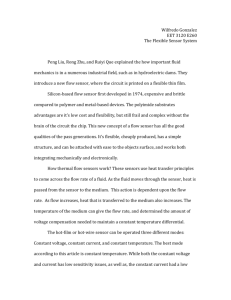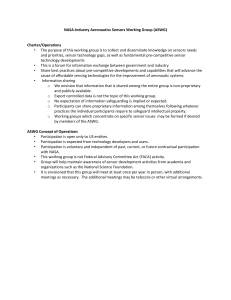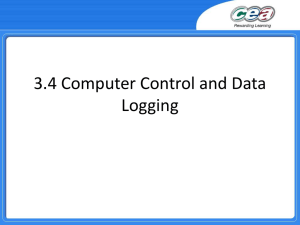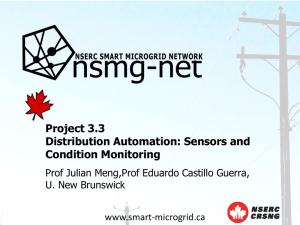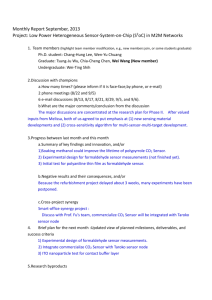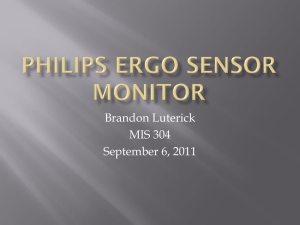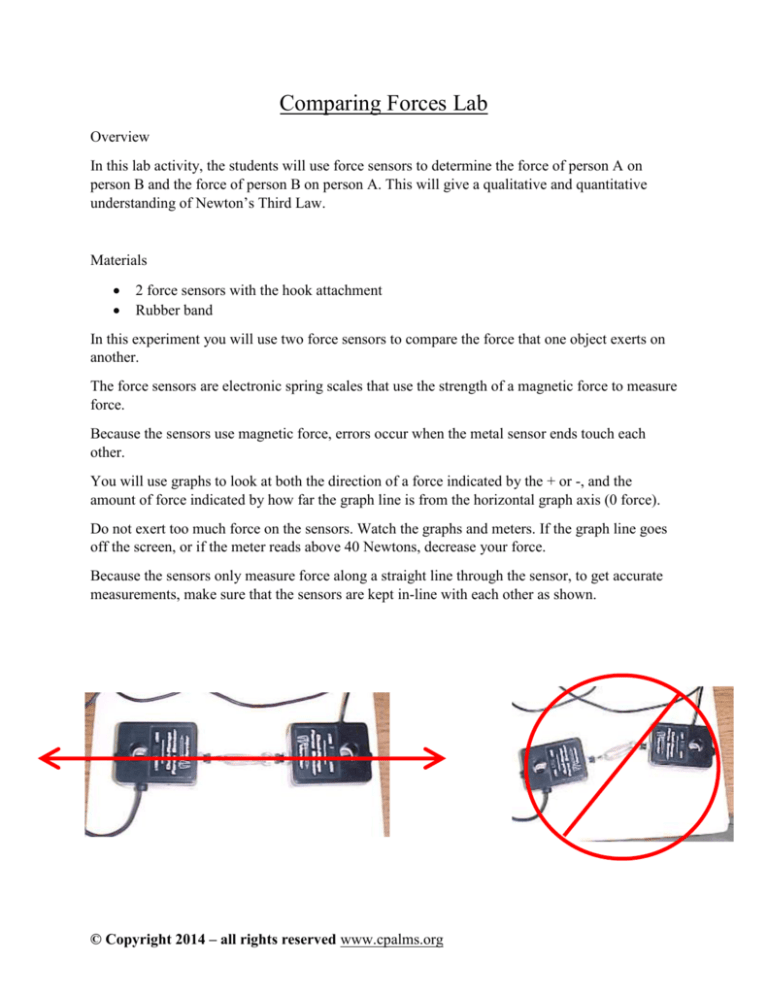
Comparing Forces Lab
Overview
In this lab activity, the students will use force sensors to determine the force of person A on
person B and the force of person B on person A. This will give a qualitative and quantitative
understanding of Newton’s Third Law.
Materials
2 force sensors with the hook attachment
Rubber band
In this experiment you will use two force sensors to compare the force that one object exerts on
another.
The force sensors are electronic spring scales that use the strength of a magnetic force to measure
force.
Because the sensors use magnetic force, errors occur when the metal sensor ends touch each
other.
You will use graphs to look at both the direction of a force indicated by the + or -, and the
amount of force indicated by how far the graph line is from the horizontal graph axis (0 force).
Do not exert too much force on the sensors. Watch the graphs and meters. If the graph line goes
off the screen, or if the meter reads above 40 Newtons, decrease your force.
Because the sensors only measure force along a straight line through the sensor, to get accurate
measurements, make sure that the sensors are kept in-line with each other as shown.
© Copyright 2014 – all rights reserved www.cpalms.org
Pre-Lab Questions
1) The force sensors use _____magnets_______to measure force.
2) Because the force sensors use magnets, the _____metal sensors______ should not come in
contact with each other.
3) If the scale reading goes higher than ____40_____ Newtons, you should decrease the amount
of force.
4) To measure accurately, the sensors must be kept _____in-line_____ with each other.
5) How does the graph show the direction of a force? If the force is positive or negative (line is
located above the x axis or below the x axis)
6) How does the graph show the amount of a force? How far the graph line is located away from the
0 axis
Procedure
•
Open Logger Pro 3.4.1 on the computer that has the force sensors attached.
•
Open the file “comparing forces”
•
With the force sensors laying flat on the desk, and not pulling or pushing on anything,
click the Ø button which is near the top left. This will open a window in which you can
zero the force sensors. This tells the sensors what no force feels like. After zeroing the
sensors, both meters should show 0 N. They will probably vary a little bit.
•
Determine which sensor is 1 and which is 2 by pushing or pulling on the eyehook and
watching the meter.
•
Connect the force sensors to each other with a doubled rubber band.
•
Make sure during all data collections that the sensors stay flat on the table, and that they
stay in line with each other.
© Copyright 2014 – all rights reserved www.cpalms.org
Experiment 1
Hold sensor 1 in place. Click the “Start” arrow in the upper right of the screen. Pull sensor 2
away from sensor one, varying the stretch in the rubber band. Data will be collected for 10
seconds. On your data sheet, sketch the shapes of the graphs and answer the questions.
Hold in place
Pull
Experiment 1 Questions
In your lab notebook, sketch the force vs. time graph for sensor 1 and sensor 2, then answer the
following questions. Student sample answers are provided.
1.
2.
3.
4.
5.
What is the magnitude of the force for sensor 1? 20 Newtons
What is the magnitude of the force for sensor 2? 20 Newtons
What is the direction of the force for sensor 1 (positive or negative)? positive
What is the direction of the force for sensor 2 (positive or negative)? negative
How do the magnitudes and directions for each sensor compare? The magnitudes are the
same, the directions are opposite.
© Copyright 2014 – all rights reserved www.cpalms.org
Experiment 2
Hold sensor 2 in place. Click the “Start” arrow in the upper right of the screen. Pull sensor 1
away from sensor one, varying the stretch in the rubber band. Data will be collected for 10
seconds. On your data sheet, sketch the shapes of the graphs and answer the questions.
Pull
Hold in place
Experiment 2 Questions
In your lab notebook, sketch the force vs. time graph for sensor 1 and sensor 2, then answer the
following questions. Student sample answers are provided.
1.
2.
3.
4.
5.
What is the magnitude of the force for sensor 1? 20 Newtons
What is the magnitude of the force for sensor 2? 20 Newtons
What is the direction of the force for sensor 1 (positive or negative)? positive
What is the direction of the force for sensor 2 (positive or negative)? negative
How do the magnitudes and directions for each sensor compare? The magnitudes are the
same, the directions are opposite.
© Copyright 2014 – all rights reserved www.cpalms.org
Experiment 3
Click the “Start” arrow in the upper right of the screen. Pull both sensor 1 and sensor 2 away
from each other, varying the stretch in the rubber band. Data will be collected for 10 seconds. On
your data sheet, sketch the shapes of the graphs and answer the questions.
Pull
Pull
Experiment 3 Questions
In your lab notebook, sketch the force vs. time graph for sensor 1 and sensor 2, then answer the
following questions. Student sample answers are provided.
1.
2.
3.
4.
5.
What is the magnitude of the force for sensor 1? 20 Newtons
What is the magnitude of the force for sensor 2? 20 Newtons
What is the direction of the force for sensor 1 (positive or negative)? positive
What is the direction of the force for sensor 2 (positive or negative)? negative
How do the magnitudes and directions for each sensor compare? The magnitudes are the
same, the directions are opposite.
© Copyright 2014 – all rights reserved www.cpalms.org
Experiment 4
Click the “Start” arrow in the upper right of the screen. Use sensor 1 to pull sensor 2 across the
table. Sensor 2 should resist, but move with sensor 1. Vary the stretch in the rubber band as you
move. Data will be collected for 10 seconds. On your data sheet, sketch the shapes of the graphs
and answer the questions.
Follow with resistance
Pull
Experiment 4 Questions
In your lab notebook, sketch the force vs. time graph for sensor 1 and sensor 2, then answer the
following questions. Student sample answers are provided.
1.
2.
3.
4.
5.
What is the magnitude of the force for sensor 1? 20 Newtons
What is the magnitude of the force for sensor 2? 20 Newtons
What is the direction of the force for sensor 1 (positive or negative)? positive
What is the direction of the force for sensor 2 (positive or negative)? negative
How do the magnitudes and directions for each sensor compare? The magnitudes are the
same, the directions are opposite.
© Copyright 2014 – all rights reserved www.cpalms.org
Experiment 5
Click the “Start” arrow in the upper right of the screen. Use sensor 2 to pull sensor 1 across the
table. Sensor 1 should resist, but move with sensor 2. Vary the stretch in the rubber band as you
move. Data will be collected for 10 seconds. On your data sheet, sketch the shapes of the graphs
and answer the questions.
Pull
Follow with resistance
Experiment 5 Questions
In your lab notebook, sketch the force vs. time graph for sensor 1 and sensor 2, then answer the
following questions. Student sample answers are provided.
1.
2.
3.
4.
5.
What is the magnitude of the force for sensor 1? 20 Newtons
What is the magnitude of the force for sensor 2? 20 Newtons
What is the direction of the force for sensor 1 (positive or negative)? positive
What is the direction of the force for sensor 2 (positive or negative)? negative
How do the magnitudes and directions for each sensor compare? The magnitudes are the
same, the directions are opposite.
Conclusion
In your lab notebook, write a 5-7 sentence conclusion summarizing your findings in the lab. The
questions to each experiment can be used to help formulate a conclusion. Comparisons should be
made between the results for each experiment. Look for common trends among each experiment
to help piece together a definition for Newton’s Third Law. Student sample answers are
provided.
In each of the experiments I completed during the lab, I noticed the magnitude of the force on
sensors 1 and 2 were the same. I also noticed the direction of the force on sensors 1 and 2 were
© Copyright 2014 – all rights reserved www.cpalms.org
opposite. I found this interesting because even though the situations for each experiment
changed, the magnitude and directions of the forces are always equal and opposite. I can
determine that no matter what is occurring with a pair of forces, the forces will always be equal
and opposite. Therefore, a possible definition for Newton’s 3rd Law would be forces always
occur in pairs and the pairs are always equal in magnitude and opposite in direction.
© Copyright 2014 – all rights reserved www.cpalms.org

